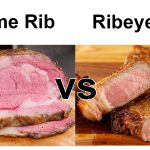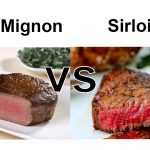There is a lot of confusion when it comes to understanding the difference between spare ribs and St. Louis ribs. Many BBQ enthusiasts make the mistake of thinking they are one and the same, but in reality there are some subtle differences that can greatly impact your cooking experience.
In this blog post, we will discuss what sets these two types of ribs apart so you can choose which cut works better with your meal planning. We will also dive into how to select quality racks for barbecuing as well as essential tips on getting perfect results each time. So whether you’re a beginner or an experienced griller, come join us for a lesson about spare vs St Louis rib cuts!
What Is Spare ribs ?
Spare ribs sometimes referred to as “side ribs,” are cut from the belly side of the rib cage, which is located below the loin. These slabs of ribs have more fat than other cuts and feature a thick layer of meat between two layers of bones. A full rack typically contains 11-13 bones and is usually wider in size.
Due to its higher fat content, spareribs are considered one of the most flavorful cuts for slow cooking or smoking over direct heat. Spareribs often require longer cooking times to reach optimal tenderness – up to 7 hours depending on your method and desired level of doneness.

Spare Ribs Nutrition Facts:
Serving Size: 3 ounces (85g)
Calories: 150
Total Fat: 5 g
Saturated Fat: 2 g
Trans Fat 0 g
Cholesterol 50 mg
Sodium 160 mg
Total Carbohydrate 0 g
Dietary Fiber 0 g
Sugars 0 g
Protein 21 g
Vitamins and Minerals: Vitamin A 0%, Calcium 1%, Iron 4%
Percent Daily Values are based on a 2,000 calorie diet. Your daily values may be higher or lower depending on your calorie needs. Spare ribs provide an excellent source of protein as well as essential vitamins and minerals. They can be enjoyed grilled, smoked, or oven-roasted. When selecting spare ribs, look for ribs with marbling and that have no discoloration. Avoid ribs that have a slimy texture or an unpleasant odor.
Spare ribs can be enjoyed in many different dishes such as classic American barbecue, Chinese char siu pork buns, Korean BBQ galbi jjim and sweet Thai pork rib soup. They are also wonderful on their own served with some sides like baked beans and coleslaw! Spareribs are versatile and can be cooked in a variety of ways to suit any taste buds!
What Is St Louis-Style Ribs?
St Louis-style ribs are cut from the same part of the rib cage as spareribs, but they differ in shape. These slabs have less fat and are trimmed of excess cartilage and meat so that they appear more rectangular in shape with well-defined edges. A full rack typically contains 7-9 bones and is usually narrower in size than a slab of spareribs.
St Louis-style ribs can be cooked over direct heat or indirect heat, although some barbecuers prefer to marinate them first for extra flavor. They usually require slightly shorter cooking times to achieve optimum tenderness (approximately 5 hours) compared to spareribs.

St Louis Ribs Nutrition Facts:
Serving Size: 3 ounces (85g)
Calories: 170
Total Fat: 6 g
Saturated Fat: 2 g
Trans Fat 0 g
Cholesterol 55 mg
Sodium 130 mg
Total Carbohydrate 0 g
Dietary Fiber 0 g
Sugars 0 g
Protein 20 g
Vitamins and Minerals: Vitamin A 0%, Calcium 1%, Iron 4%
Percent Daily Values are based on a 2,000 calorie diet. Your daily values may be higher or lower depending on your calorie needs.
St Louis ribs are similar to spare ribs but have been trimmed of some exterior fat and the breastbone has been removed to give them a rectangular shape. They are often cooked in the same ways as spare ribs and can be enjoyed grilled, smoked, or oven-roasted. When selecting St Louis ribs, look for ones with marbling and that have no discoloration. Avoid ribs that have a slimy texture or an unpleasant odor.
What Is The Difference Between Spare Ribs and St Louis Ribs ?
The main difference between spare ribs and St Louis ribs is their shape. Spareribs are cut from the long side of the rib cage, while St Louis ribs are trimmed to a rectangular shape with well-defined edges. The other key differences include fat content and cooking time spareribs have more fat which takes longer to cook through than St Louis ribs.
Additionally, St Louis ribs contain fewer bones per slab compared to spareribs, making them ideal for smaller cuts of meat or as a single-serving option. Ultimately, both types of ribs offer delicious flavor and can be enjoyed in many different dishes!

4 Difference Between Spare Ribs and St Louis Ribs:
1. Shape: Spareribs are cut from the long side of the rib cage, while St Louis ribs are trimmed to a rectangular shape with well-defined edges.
2. Fat Content: Spareribs have more fat than St Louis ribs.
3. Bones Per Slab: A full rack of spareribs typically contains 11-13 bones compared to 7-9 for St Louis ribs.
4. Cooking Time: Spareribs require longer cooking times over indirect heat (up to 7 hours) than St Louis ribs (5 hours).
Similarities of St Louis Ribs vs Spare Ribs
Both spare and St Louis ribs provide an excellent source of protein and essential vitamins and minerals. They can be enjoyed grilled, smoked, or oven-roasted and require similar cooking times depending on the desired level of doneness. When selecting either type of rib cut, look for ones with marbling that have no discoloration. Avoid ribs that have a slimy texture or an unpleasant odor.
St Louis Ribs vs Spare Ribs: Which Is Better?
The answer to this question ultimately depends on personal preference and the type of dish you are making. Both spare ribs and St Louis ribs offer delicious flavor, but they have some key differences that make them better suited for various dishes. Spareribs may be the better choice if you’re looking for a hearty and flavorful cut of meat with higher fat content, while St Louis ribs may be preferable if you’re after smaller cuts or serving individual portions. Ultimately, both types of ribs can make a great addition to any backyard barbecue or cookout!
Whether you’re an experienced griller or just starting out, understanding the difference between spare vs St Louis rib cuts is essential for getting perfect results every time.
How To Choose Quality Rib Racks
When it comes to selecting ribs, it’s important to look for quality. Spare and St Louis-style rib racks should be pinkish in color with white fat marbling throughout the meat. The bones should be firmly connected to the meat and not easily breakable when handled.
Inspect each rack carefully for any signs of discoloration or bruising before purchasing. Fresh ribs typically have a pleasant smell – if you detect any off-odors, they’re probably past their prime and should be avoided.
Cooking Tips For Perfect Ribs Every Time
Now that you know how to choose quality slabs, it’s time to learn some essential tips on getting perfect results every time! Whether you prefer spareribs or St Louis-style ribs, the same basic principles apply.
Start by removing the membrane from the backside of the rack before seasoning with your favorite dry rub or marinade. For best results, allow your ribs to sit overnight in the refrigerator so that flavors can penetrate all the way through.
When it’s time to cook, always remember low and slow – set your smoker or grill at 225-250°F and cook for 5-7 hours, depending on the type of rib. If possible, rotate racks throughout cooking for even heat distribution and add wood chips for smoky flavor. Finally, let your cooked ribs rest for at least 15 minutes before serving this will lock in all those delicious juices!
FAQs Spare ribs vs St louis
What is the difference between St Louis ribs and spare ribs?
The main difference between St Louis ribs and spareribs is their shape. Spareribs are cut from the long side of the rib cage, while St Louis ribs are trimmed to a rectangular shape with well-defined edges. Additionally, St Louis ribs contain fewer bones per slab compared to spareribs, making them ideal for smaller cuts of meat or as a single-serving option.
How long do I need to cook my ribs?
This will depend on what type of rib you’re cooking and your desired level of doneness. For both spareribs and St Louis-style ribs, it’s best to cook low and slow at 225-250°F for 5-7 hours.
Can I substitute spare ribs for St Louis ribs?
Yes, you can substitute spare ribs for St Louis ribs in most recipes. However, keep in mind that spareribs have more fat content and require longer cooking times than St Louis ribs.
What is the nutritional value of St Louis ribs?
St Louis-style ribs are an excellent source of protein and essential vitamins and minerals. Per 3-ounce serving, they contain roughly 150 calories, 18g protein, 5g fat, and no carbohydrates. Additionally, a serving provides 35% of your daily recommended iron intake – making them great for those on a low calorie diet. Your daily values may be higher or lower depending on your calorie needs.
What are spare ribs vs baby back ribs vs St Louis?
Spare ribs and St Louis-style ribs are cut from different parts of the rib cage. Spareribs come from the long side, while St Louis ribs have a shape with more defined edges and fewer bones per slab. Baby back ribs, on the other hand, come from the upper portion of the rib cage near the loin and contain fewer bones than spareribs or St Louis-style ribs. Additionally, baby back ribs tend to be leaner and require less cooking time than other types of ribs.
Do I need to remove the membrane before cooking my ribs?
Yes! Removing the membrane prior to cooking is essential for achieving tender, juicy results every time. For best results, use a butter knife or a pair of kitchen scissors to remove the membrane before seasoning and cooking your ribs.
Why are they called St Louis style ribs?
St Louis-style ribs are named after the city of St Louis, Missouri – where they were first popularized. The name originates from their rectangular shape with well-defined edges, which was originally created by trimming away unnecessary fat and cartilage. This style of rib is now commonly found in restaurants and supermarkets across the country!
How to trim spare ribs to St louis style?
If you’re looking to make St Louis-style ribs from spareribs, the process is relatively simple. Start by cutting off any excess fat or cartilage from the outside of the racks. Next, cut along each rib bone and remove them from the main slab of meat this will create a rectangular shape with well-defined edges. Finally, trim down any remaining fat or membrane for a perfectly uniform rack of ribs!
What’s the best way to cook St Louis ribs?
The best way to cook St Louis ribs is over indirect heat at a low temperature for several hours. This will ensure that all those delicious flavors have time to penetrate through the meat. When your ribs reach an internal temperature of 195°F (or until tender), you may move them directly over the flame or coals if you’d like to add a bit of char. Finally, always remember to let your ribs rest for at least 15 minutes before serving!
Conclusion
Differentiating between spare ribs and St Louis-style ribs may seem confusing at first, but it doesn’t have to be! We hope this guide has given you a better understanding of the subtle distinctions between these two cuts as well as tips on selecting quality racks for barbecuing. Now that you know the basics, go ahead and impress your guests with delicious spare or St Louis-style ribs every time!

William Lariviere is a chef and restaurateur with over 25 years of experience in the food industry. He is the owner and operator of Swartzsdeli.com, an online restaurant that specializes in gourmet sandwiches and salads, grill & smoke. He likes to share experience, food, recipes cooking knowledge as well as reviews about restaurant and kitchen products.
William’s goal is to provide his customers with healthy, delicious food that is also affordable and develop Swartzsdeli.com into a comprehensive information site specializing in cooking and cuisine to a new level to help reach a wide range of housewives and readers.








